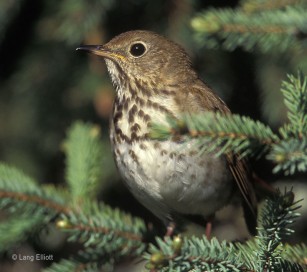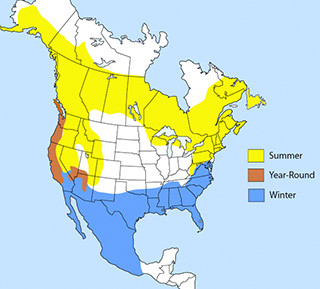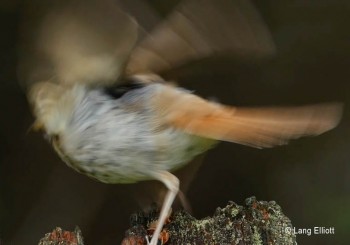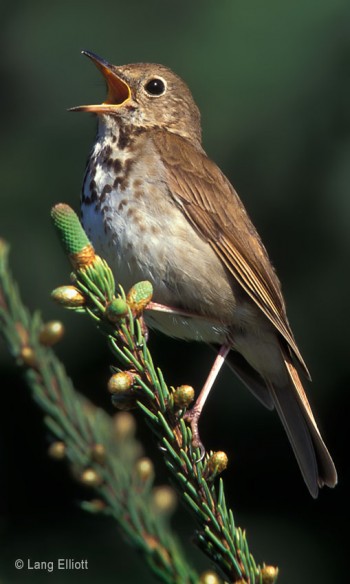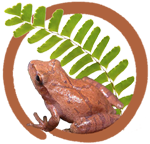Hermit Thrush – Ethereal Singer
A Nature Vignette by Lang Elliott
The Hermit Thrush is perhaps North America’s most highly regarded singer, both for musicality and emotional impact. The Hermit’s enchanting song begins with a clear whistled note, followed by a rapid flutelike jumble of notes having a ventriloquial quality. Each male has several different song patterns in its repertoire and rarely repeats the same song twice in a row. Poets and naturalists are united in their praise of the Hermit Thrush’s song, describing it variously as tender, serene, wild, ethereal, peaceful, solemn, and ecstatic – adjectives that ascribe an exalted, religious quality to the song (see below for quotes from well-known naturalists and poets).
A Beautiful Hermit Thrush Recording:
Deep in the dark, primeval forest, Hermit Thrushes spin their songs, silken melodies fit for the heavens … awakened, enlightened, fluting pure light. Relax into this ethereal mix of sounds and and be carried into the heavenly joy of nature’s sweet embrace.
Recorded at 5:30am, 25 June 2000, in the Adirondack Mountain near Tupper Lake, NY. © Lang Elliott. Listen also for Coyotes, Barred Owls hooting, and faint calls of Green Frogs and Bullfrogs.
1. The male’s musical song begins with a pure tone, followed by a flutey jumble of notes. Each male has five to ten different songtypes and rarely if ever sings the same pattern twice in a row:
2. A common call is a drawn-out nasal way, often heard at dusk.
3. When agitated or alarmed, individuals give staccato churt calls. Another call is a whistled veeee, associated with flight and migration. Both these calls are featured in the following recording:
The exquisite beauty and extraordinary complexity of the Hermit Thrush’s song is best experienced by slowing songs down to around one-fourth normal speed. This lowers the pitch of the songs into the range of human music, and allows the listener to hear and appreciate rapid transitions between notes.
In the following example, I’ve slowed eight songs and removed the silence between them, so that you can hear them one after the other in quick succession. The complexity of the terminal flutey rambles is impressive:
Appearance: Rich brown above with white underparts speckled with smudged brown spots. The tail (and often the outer wing feathers) is noticeably more reddish-brown than other areas, providing a useful field mark for identification.
Habitat & Breeding Range: Breeds in a wide variety of forest habitats, ranging from wet swamplands and bogs to dry pine woods. Found in northern forests from Newfoundland westward to Alaska, in western mountains as far south as Arizona and New Mexico, and in eastern mountains southward to West Virginia. Overwinters from the southern United States to southern Mexico. Year-round populations occur along the West Coast from northern California to Vancouver Island in British Columbia.
Habits: Migrates in early spring (earlier than our other brown thrushes) and can often be located by listening for their telltale calls and intermittent songs. Feeds on a wide variety of insects and berries, the latter being a major source during the winter months. Nests on the ground in eastern areas and in trees (up to 12′ high) in western mountains. When disturbed, may flick its wing and slowly bob its tail up and down.
John Burroughs thought the Hermit’s song to be an expression of “beatitude” that embodies “a peace and a deep, solemn joy that only the finest souls may know.” The Iroquois believed the Hermit Thrush flew high into the heavens to receive its voice from the spirit world. The melody and cadence of the song is imitated in poetry and prose, with words chosen to convey the reverence that is evoked. Burroughs likened the Hermit’s song to “O spheral, spheral … O holy, holy!” Walt Whitman translated it as “O liquid free and tender … O wild and loose my soul … O wondrous singer.”
The emotional impact of the Hermit’s beautiful song is undoubtedly related to its breeding habitat: dark, cathedral-like forests of hemlock or pine and secluded, swampy stands of cedar, tamarack and spruce. Only a “hermit” would inhabit such remote places, spinning exalted songs and choosing “thus to fling its soul upon the growing gloom,” as poet Thomas Hardy observed in “The Darkling Thrush”. Whitman conveys a similar feeling in “When Lilacs Last in the Dooryard Bloom’d:
From deep secluded recesses,
From the fragrant cedars and the ghostly pines so still,
Came the carol of a bird.
What You Can Do:
This section coming soon!
Another Beautiful Hermit Thrush Recording:
This serene soundscape begins with a lone Hermit Thrush giving nasal way calls, followed by typical songs and then churt calls. Spring Peepers sound off in the distance throughout. Recorded at dusk in the Adirondack Mountains in pine woods near a swampy area.
Recorded 6/7/00, 9:08 pm, in the Adirondack Mountains near Pauls Smith, New York. © Lang Elliott.
Notes from the Author (Lang Elliott):
 I obtained my best video clips during a trip to the Adirondack Mountains in June of 2014. My video portrait features my best clips of three different birds, and I’m quite happy with the result.
I obtained my best video clips during a trip to the Adirondack Mountains in June of 2014. My video portrait features my best clips of three different birds, and I’m quite happy with the result.
When I collected the video, I didn’t get good sound. So I went back later with my recorder and got excellent examples of the complete song repertoires of all three birds (males have six or more different song types). To make the video, I had to painstakingly find matching songs and synch them perfectly with the bill movements in post production. The result is very clean sound, far better than otherwise. Sometimes I have a field assistant who records with a parabola as I gather the video, but I was all alone up there on this occasion, and therefore had to do it the hard way.
I love all the thrushes and their fantastic songs, and I vow to produce excellent video portraits of all our species, even if I have to climb mountains and slog through bogs to do so!
Learn more about Lang at langelliott.com
Did you enjoy this intimate glimpse into the natural world?

